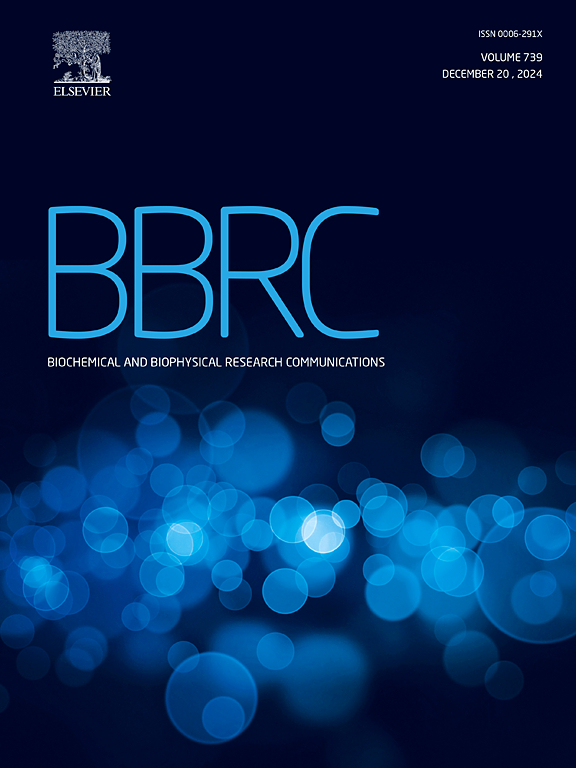Structural insights into regulated intramembrane proteolysis by the positive alginate regulator MucP from Pseudomonas aeruginosa
IF 2.5
3区 生物学
Q3 BIOCHEMISTRY & MOLECULAR BIOLOGY
Biochemical and biophysical research communications
Pub Date : 2024-11-14
DOI:10.1016/j.bbrc.2024.150999
引用次数: 0
Abstract
Regulated intramembrane proteolysis (RIP) is a fundamentally conserved mechanism involving sequential cleavage by a membrane-bound Site-1 protease (S1P) and a transmembrane Site-2 protease (S2P). In the opportunistic pathogen Pseudomonas aeruginosa, the alternate sigma factor σ22 activates alginate production and in turn is regulated by the MucABCD system. The anti-sigma factor MucA, which inhibits σ22, is sequentially cleaved via RIP by AlgW (S1P) and MucP (S2P) respectively. In this study, we report high-resolution crystal structures of the MucP PDZ1 and PDZ2 domains. Structural and binding analysis confirms that MucP PDZ2 recognizes the carboxy-terminal Ala136 residue of MucA following Site-1 cleavage by AlgW, while the peptide binding groove of PDZ1 is obstructed by a short α-helix. A structure of MucP PDZ2 with bound MucA peptide shows how PDZ2 binds the newly exposed carboxyl terminus of MucA following AlgW cleavage. The ability of a ΔmucP strain of P. aeruginosa to form biofilms was reduced to a similar extent as a ΔalgW strain. This work paves the way for further studies of MucP and other PDZ-containing S2Ps in regulated intramembrane proteolysis.
铜绿假单胞菌的藻酸盐正调控因子 MucP 调节膜内蛋白水解作用的结构研究。
调控膜内蛋白水解(RIP)是一种基本保守的机制,涉及膜结合位点-1蛋白酶(S1P)和跨膜位点-2蛋白酶(S2P)的顺序裂解。在机会性病原体铜绿假单胞菌(Pseudomonas aeruginosa)中,交替σ22因子激活藻酸盐的产生,反过来又受MucABCD系统的调节。抑制σ22的反σ因子MucA通过RIP依次被AlgW(S1P)和MucP(S2P)分别裂解。本研究报告了 MucP PDZ1 和 PDZ2 结构域的高分辨率晶体结构。结构和结合分析证实,MucP PDZ2 在被 AlgW 的 Site-1 裂解后能识别 MucA 的羧基末端 Ala136 残基,而 PDZ1 的肽结合沟被一个短的α-螺旋阻挡。带有结合的 MucA 肽的 MucP PDZ2 的结构显示了 PDZ2 是如何在 AlgW 裂解后与 MucA 新暴露的羧基末端结合的。铜绿假单胞菌的 ΔmucP 菌株形成生物膜的能力与 ΔalgW 菌株的能力相似。这项工作为进一步研究 MucP 和其他含 PDZ 的 S2P 在调节膜内蛋白水解过程中的作用铺平了道路。
本文章由计算机程序翻译,如有差异,请以英文原文为准。
求助全文
约1分钟内获得全文
求助全文
来源期刊
CiteScore
6.10
自引率
0.00%
发文量
1400
审稿时长
14 days
期刊介绍:
Biochemical and Biophysical Research Communications is the premier international journal devoted to the very rapid dissemination of timely and significant experimental results in diverse fields of biological research. The development of the "Breakthroughs and Views" section brings the minireview format to the journal, and issues often contain collections of special interest manuscripts. BBRC is published weekly (52 issues/year).Research Areas now include: Biochemistry; biophysics; cell biology; developmental biology; immunology
; molecular biology; neurobiology; plant biology and proteomics

 求助内容:
求助内容: 应助结果提醒方式:
应助结果提醒方式:


